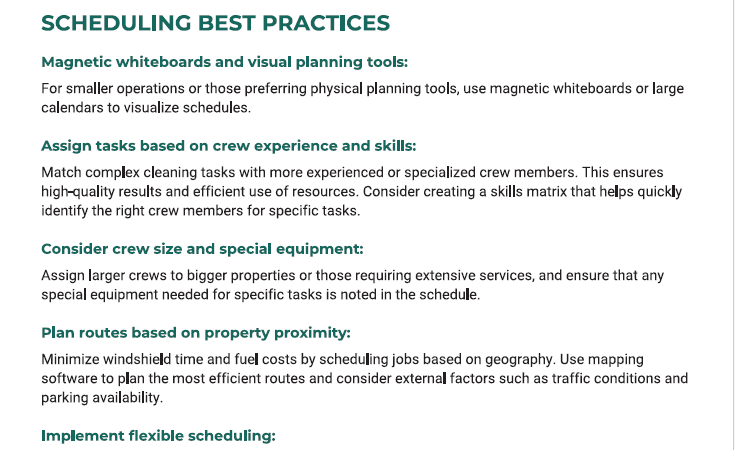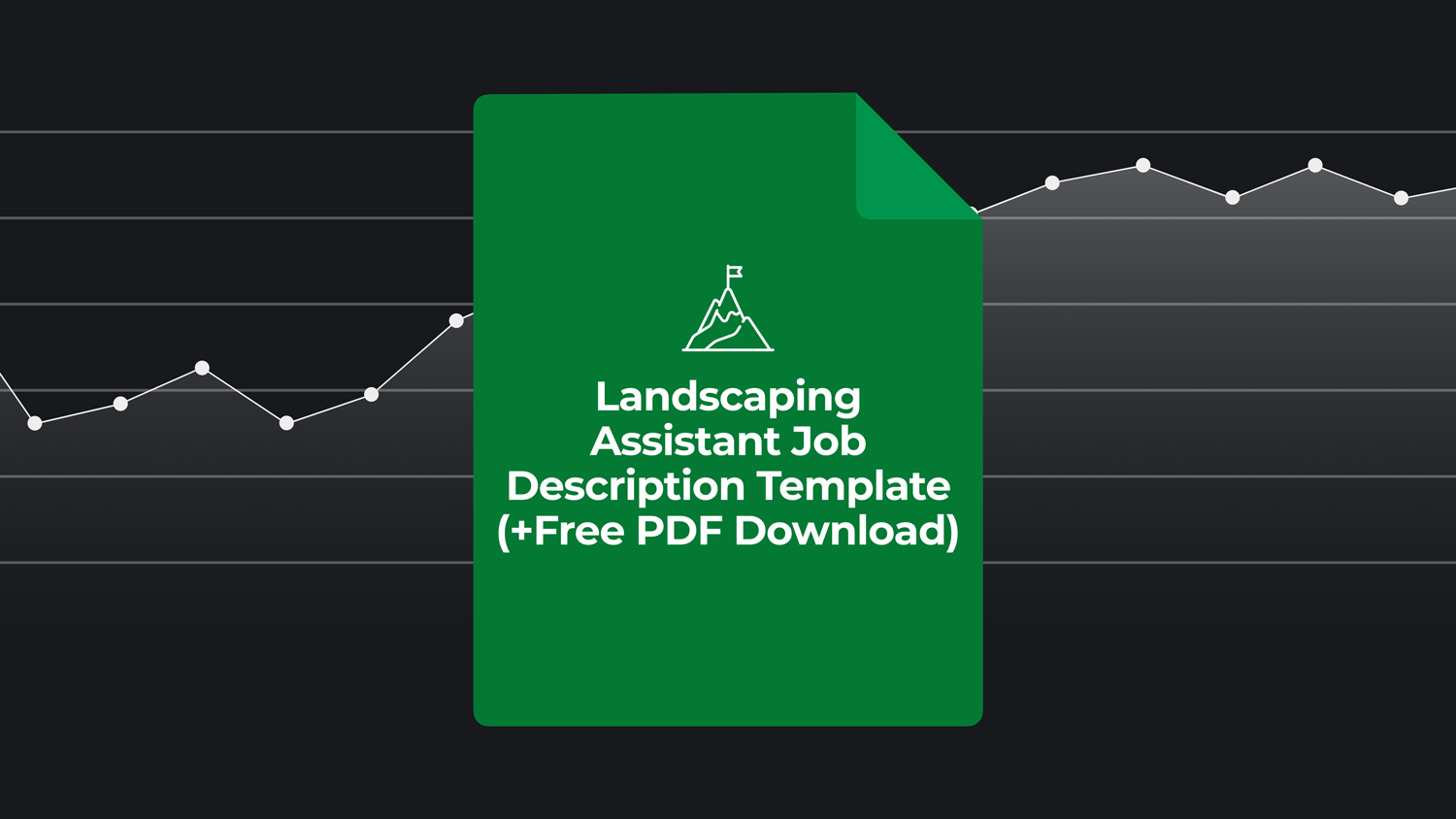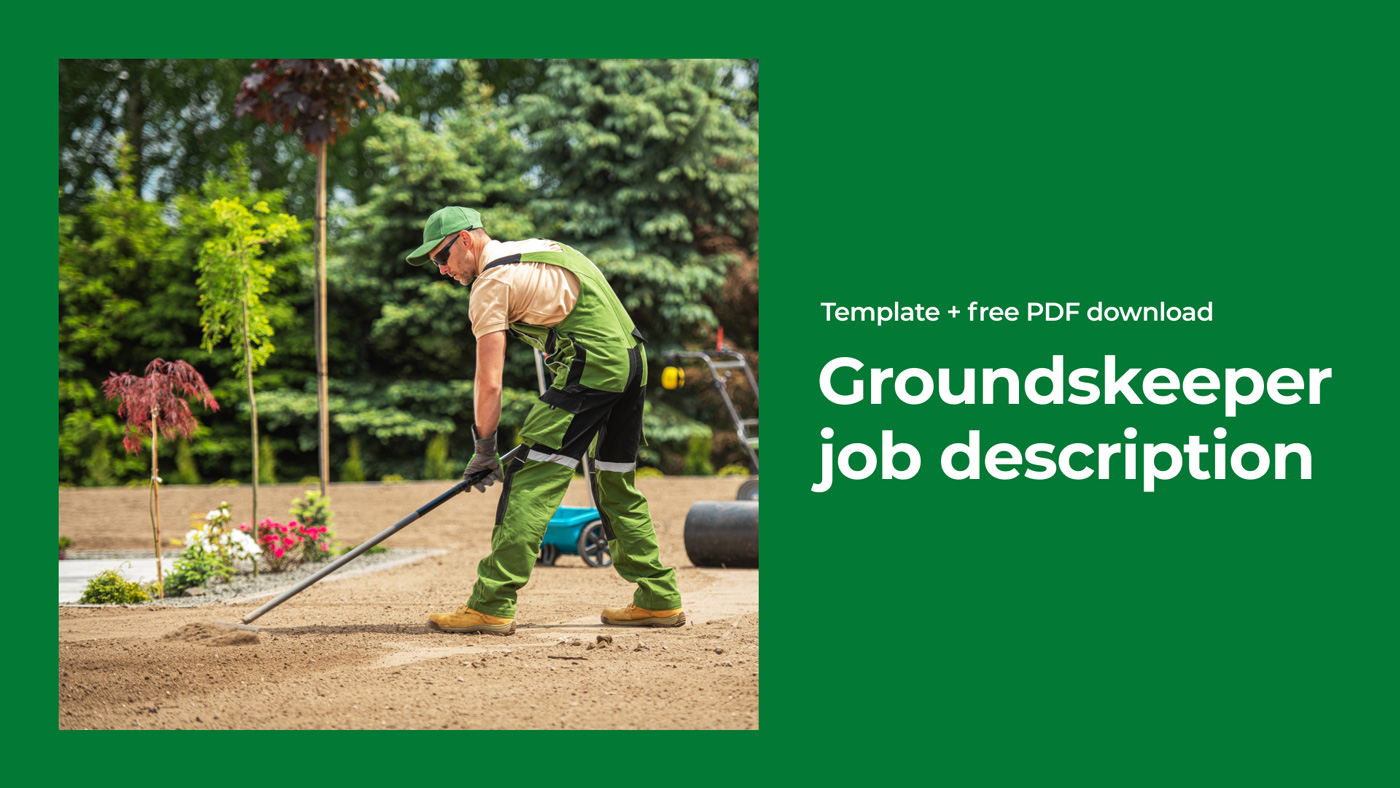Table of Contents
Table of Contents
- Introducing your cleaning schedule template
- What is a cleaning schedule?
- Why does your cleaning company need a cleaning schedule?
- What are the different kinds of cleaning schedules?
- How can you use a cleaning schedule template effectively?
- Going beyond templates: Manage your cleaning business efficiently with Aspire
- It’s your turn now
A cleaning schedule is critical for businesses managing multiple crews and daily routes. A structured and organized schedule ensures team members have enough time to deliver high-quality service while maintaining profit margins.
However, creating and sharing a cleaning schedule with team members can be tricky without the right tools.
That’s where a cleaning schedule template comes in. This template makes it easy to streamline your scheduling process, stay organized, and create optimized efficient routes.

Introducing your cleaning schedule template
An optimized cleaning schedule template means all jobs are covered, resources are used effectively, and client expectations are met. The template covers all the basics, like crew assignments, time slots, and property addresses, so everything is clear and accountable for each job.
Special notes like "use the side entrance" or "check in with building security" make it easy to adapt to client-specific requirements.
Customize this template by adding or removing tasks based on property size, adjusting service frequency to match client demand, or including special services like window cleaning or grout maintenance.
For example, a larger office may need daily break room cleaning and weekly light fixture dusting, and a smaller property may require less attention.
→ Visual planning tools like magnetic boards or mapping software can be used to arrange crews efficiently and reduce travel time.
Download the template now, reduce missed tasks, increase operational efficiency, and deliver high-quality service.
By customizing the cleaning schedule template for your business, you can be more productive, and your spaces will be consistently clean and maintained.
What is a cleaning schedule?
A cleaning schedule is a structured plan that outlines the properties and routes for each cleaning crew, complete with addresses, special instructions, and job tasks.

For cleaning businesses, it ensures high-quality service for customers no matter the day or crew servicing their property. A cleaning checklist template is a guide to help operations visualize their routes and assign properties based on crew size, experience, and special skills.
This is useful for growing cleaning businesses that manage multiple crews and more complex routes.
It achieves better consistency, task completion, and time management.
Cleaning Schedule Breakdown:
Create crews: Assign a leader and staff crews by considering experience level, tenure with the company, and special skills such as floor buffing, window cleaning, etc.
Daily time slots: Block out time in the day based on how long properties take to complete, including windshield time traveling between jobs.
Property addresses: Let crew leaders see the extent of their route at a glance with addresses of the job sites—group customers who are close together into the same route.
Job tasks: Every property should include a list of the tasks to be completed so crews can stock their vehicle with the required equipment and supplies before they start their day.
Special notes: Make notes on where to check in at a property, any security codes they might need, and special requests from the customer.
Schedule downtime: Pad the schedule with extra time in case something goes wrong at a property (like issues with entry or difficulty completing specialty services) so the crew won’t get behind because of the unexpected.
A cleaning schedule template ensures no task is missed and your spaces are consistently clean and organized.
Why does your cleaning company need a cleaning schedule?
A cleaning schedule helps cleaning businesses streamline their operations, be more productive, and deliver consistent results. Companies can improve their workflow and service by having a cleaning schedule template.
1. Ensures Consistency
By putting cleaning tasks on the schedule, your crews won’t miss tasks like cleaning bathrooms or dusting light fixtures.
Consistency is key to customer satisfaction, as clients expect their spaces to be spotless over time. A structured cleaning checklist keeps services on track.
2. Saves Time
With a cleaning schedule template, planning is easy. You can build routes around your maintenance contracts and see property locations at a glance to group nearby customers.
An optimized route eliminates unnecessary delays, such as excessive windshield time, and the cleaning team knows what to do at each job.
3. Increases Efficiency
A cleaning checklist for each property lets teams review the job requirements at the start of the day and once they arrive on site. Whether floor cleaning or janitorial services, assigning tasks using the schedule means crew leaders are prepared and ready to go at every job.
4. Reduces Stress
The template gives direction and eliminates confusion about the crew servicing each property. It provides peace of mind knowing crew leaders have a list of tasks so that nothing will be missed. A solid plan keeps your team organized and less overwhelmed.
A cleaning schedule template keeps your cleaning company on top of tasks, more efficient, and delivers consistent results.
What are the different kinds of cleaning schedules?
Cleaning schedules can vary depending on the size of a company, how many crews they run, and the size of their service area.

A schedule template helps you to think about your customer base based on tasks and property location, driving new efficiency in resource allocation.
Here are the regular cleaning schedule types used in residential and commercial areas.
Daily maintenance schedules: Properties with daily cleaning needs, such as office buildings or medical facilities, will appear on the schedule daily. These schedules break down the day into time slots, with crews assigned to properties based on proximity and task complexity. Tasks typically include routine services like trash removal, surface disinfecting, and restroom maintenance.
Weekly visit schedules: Clients who require regular but less frequent cleaning, such as small businesses or shared office spaces. Weekly schedules focus on deeper cleaning tasks like vacuuming carpets, cleaning windows, and maintaining floors. Most routes will have a balance of daily maintenance jobs and weekly site visits.
Monthly services: Clients who request periodic services, such as deep cleaning or specialized tasks like carpet shampooing or tile grout cleaning. Monthly schedules are also helpful in planning recurring maintenance at properties with light usage or seasonal needs. They typically require larger time blocks than daily and weekly visits.
Seasonally scheduled service: Many commercial cleaning clients have unique needs that don’t fit into a standard schedule. These schedules are tailored to specific contracts, with detailed job requirements and task frequencies. Custom schedules should include notes on specialized equipment, client preferences, or additional services like post-construction cleanup.
How can you use a cleaning schedule template effectively?
A cleaning schedule template should be printable so everyone on the crew has a copy of their itinerary and an on-the-job to-do list. Here are some cleaning tips to get the most out of your printable cleaning schedule.
1. Set Realistic Routes
It’s natural to want to maximize efficiency by scheduling as many properties as possible in a day, but overcrowded routes often backfire. Underestimating travel time between jobs or not accounting for unexpected delays can lead to burnout, frustration, and rushed service.
Instead, plan routes realistically by:
Factoring in travel time between properties to avoid delays
Build in buffer time for unexpected issues, such as entry problems or specialized tasks that take longer than anticipated
Balanced schedules improve morale and allow your crews to deliver consistently excellent service, driving customer satisfaction and loyalty.
2. Prioritize Nearby Properties
Geography is king when it comes to optimizing routes. Group properties that are close together and assign them to the same crew to reduce travel time. When scheduling, consider:
Job requirements to match jobs with the right crew based on experience, equipment needs, and property size.
Be prepared to change crews or shift assignments daily to ensure all jobs are covered efficiently.
Strategic grouping saves time, reduces fuel costs, and maximizes the number of jobs completed without overloading your team.
3. Communicate Clearly with Crews
Ensure every team member understands their assignments and has access to critical details for each property, such as:
Job-specific tasks and expectations.
Special instructions like security codes or access protocols.
Required equipment and supplies for the day.
Providing clear communication and detailed schedules minimizes confusion, boosts accountability, and helps crews start their day prepared.
4. Monitor and Adjust Routes
Even the most well-planned schedules can encounter hiccups. Monitor your teams’ progress throughout the day and be ready to adjust as needed:
Collect crew input about their challenges on routes and adjust future schedules accordingly.
Use data to identify bottlenecks, improve time management, and optimize task assignments.
Regular evaluation ensures your schedule stays adaptable and aligned with business growth.
5. Empower Crews to Track Progress
Encourage your teams to use the schedule template as a real-time tracking tool. Whether on paper or digitally, tracking completed tasks helps:
Keep everyone accountable.
Identify missed or incomplete tasks early.
Ensure every property meets client expectations.
Following these tips, your cleaning schedule template becomes more than just a planning tool—it becomes the backbone of a streamlined, efficient cleaning operation.
Going beyond templates: Manage your cleaning business efficiently with Aspire
While a cleaning schedule template is useful, efficiently managing your business requires more advanced solutions.
Aspire’s cleaning business software lets you automate, track, and optimize every part of your cleaning operations. From automated scheduling to real-time job cost data and GPS tracking integrations, Aspire streamlines your processes and increases productivity.
Automated Scheduling
Aspire allows you to set up recurring cleaning contracts with ease.
Whether it’s a weekly or monthly cleaning, you can automate the job on your calendar so it appears at the same time and day every week for the duration of the contract.
Task Management
Aspire’s off-line capable mobile app for Android and iOS syncs from the Aspire platform, making it easy to update job task lists, communicate with crews in the field, and even update the schedule in real-time.
Crews can check off tasks in the app, ensuring every job gets top-tier service, even when customers request added services the day of.
Staff Coordination
With GPS-tracking and dashcam integrations, Aspire brings your crews in the field and operations team members closer together than ever before. You can stay updated on crew locations, making it easy to add last-minute jobs to routes with availability and proximity.
Reports and Analytics
Aspire gives you detailed reports on job costs, resource allocation, and time management so you can see how your cleaning schedules are working.
These analytics help you adjust crews, routes, and schedules to increase efficiency and client satisfaction.
Aspire lets you go beyond cleaning schedules to manage your cleaning business fully.
It’s your turn now
An optimized schedule, built from a template, drives consistency and efficiency in your cleaning business.
Use the free cleaning schedule template and Aspire’s software to streamline and optimize your scheduling processes.
Download the template and book a free demo with Aspire to see how end-to-end, cloud-based software can unlock new revenue potential from your existing operations.











